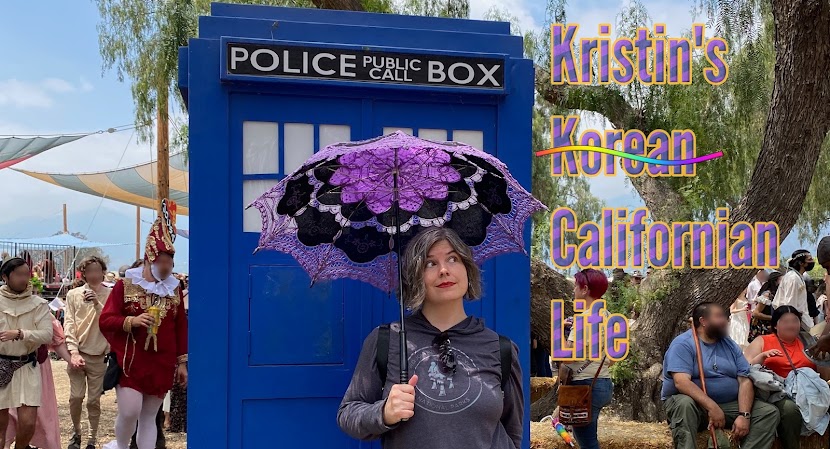I've seen one drive-thru in Korea. There are fast food restaurants, but people don't eat alone there as much as in the US. There are also kimpap chungkuk restaurants, which sell all sorts of cheap Korean food, where people sometimes eat alone. But most people eat together.
In the US, we don't think it's strange to grab a sandwich and eat alone at our desks if we're having a busy day at work. In Korea, it's almost unheard of. The whole team goes to the cafeteria or a restaurant with fast service together, eat quickly together, and go back to work together. It's just normal. Koreans eat together.
If there's time, a group of people (coworkers, friends, family) meanders through a crowded public place taking up the whole street and/or sidewalk saying, "what should we eat?" a million times before choosing a restaurant, which is invariably somewhere they have been before or at least heard from a friend is really good. Then they enter the restaurant.
Now, restaurants in Korea are different than in the US. First of all, when you enter, it's a bustling madhouse of servers and customers calling servers. To illustrate some other differences, let me give you an in-depth look at restaurants. There are three main types of common restaurants in Korea: the ones with middle aged women serving, the ones with high school or college kids serving, and bars (also usually college kids serving).
Middle aged woman (ajumma) restaurants: You walk in and signal the ajumma from across the room how many people are in your party. You can also shout if you like. She signals a table which is too close for comfort to other customers and you sit down. The menu is on the wall written vertically for some reason, and also as a paper checklist that will later serve as your receipt. On the checklist, you mark how much of each thing you want. (note to travelers: there is no English, so if you're adventurous, just say "inki itnun menu chuseyo", which means, "give me something popular") A group of Koreans will usually choose one thing each to put in the middle of the table and share. If you have 6 or 7 people, you will probably end up with spicy ramyun and rice cakes, spicy ramyun and rice cakes with cheese, spicy noodles, spicy ramyun soup, kimbap, and rice balls wrapped in seaweed. There will be a hodgepodge of vegetables (mostly green onions) and hard boiled eggs included in the dishes. Each person has their own small dish to put things on so they don't get food all over the place, and there might be some rice because Koreans don't feel like they've eaten anything unless there is rice. At least two types of kimchi are, of course, included free of charge. Silverware and water cups are on the side of the table, and the youngest people distribute them (water is in a jug and you have to yell at the ajumma to get more). When everyone has eaten their fill of everything on the table and there is one of everything left (or a little bit), it's time to get up and pay on the way out. Throughout the meal, if anything was needed, the ajumma was yelled for or a doorbell button on the table pushed for attention. There is no splitting the bill. If the oldest doesn't pay (the oldest usually pays unless it's a peer situation or coworkers), splitting the bill is done before or after actually paying.
Young kids: These are usually foreign restaurants or restaurants trying to look foreign. When you enter, you are greeted with strange, high pitched calls of, "Hello/Welcome, this is [restaurant name]". A young person will come ask you how many people in your party, and take you to or point you to your table, like in the US. That's where the similarity ends. You look at the menu, choose want you want, and push the button. This is paramount. If you do not push the button that is on your table and makes a doorbell sound, or wave down a waiter with cries of "cheogiyo" (hey you), you will not get served. Let me make that clear. It's like flight attendants on a plane, but you get less attention. You are ignored completely unless you call attention to yourself. It's wonderful. You want to order? Push the button. You aren't ready yet? Don't push the button. Awesome. Here the usual choices are whatever set menu is on special, because 90% of Koreans will eat anything. Many foreign restaurants realize they're not Korean so avoid kimchi in favor of foreign kimchi, a.k.a. pickles.
Bars: Same as young kids but the food is more expensive, and the waiters bother you sometimes because they want you to spend more money. Chicken places fall into this category because I'm going on service types. I would like to note here that Korean fried chicken is the only Western food Korea does better than the US. AWESOME. Sake places also fall into this category, especially the waiters bothering you thing.
A few things these all have in common:
(No) Personal dishes. Everything is shared. You don't order a steak for yourself. You order a steak and you get one bite of it because everyone else also gets a bite, and you'd better dig into the rest of the food or else you'll starve.
Call the waiter. Freedom when you want it, service when you want it. Only fails when there are no waiters around.
No tips. You don't tip people in Korea, and minimum wage is lower, so restaurants are cheaper. Coffe shops are the same though...
Pickled side dishes. Koreans can't feel full without pickles. They can't imagine pizza without pickles on the side because that would just be a snack.

Eating is really much enjoyable if you don't do it alone. Dine with others and mingle.
ReplyDelete